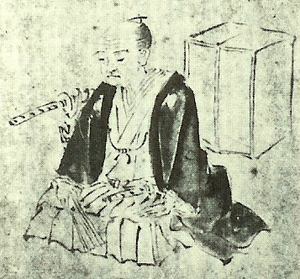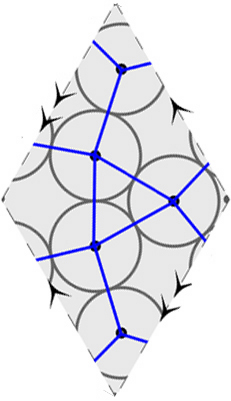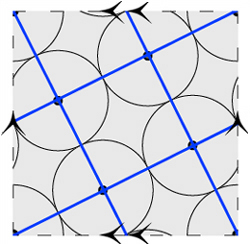This month's topics:
"Samurai mathematician"

Seki Takakazu (Seki Kowa). Image from
Tensai no Eiko to Zasetsu by Masahiko Fujiwara
(Shincho-sha, Tokyo, 2002), used with permission.
"Samurai Mathematician Set Japan Ablaze With Brief, Bright Light" is the title
of a History of Science NewsFocus piece in the October 10 2008
Science. Dennis Normile reports from Tokyo, site of
a history of mathematics conference last August dedicated to the
memory of Seki Takakazu. Seki (c. 1642-1708, also Seki Kowa)
was in fact born into a samurai family; his portrait includes the
the two swords (daisho) attesting his
warrior status.
That he "set Japan
ablaze" may be an overstatement, but the "bright light"
is appropriate: Seki (an almost exact contemporary of Leibniz,
but working in complete isolation from European mathematics)
"devised new notation for handling equations with several variables and developed solutions for equations with an unknown raised to the fifth power."
Furthermore, according to Normile,
"His most significant work focused on determinants ... , a field he
pioneered a year or two ahead of ... Leibniz." The word "brief" is,
unfortunately, also correct. Seki was ahead of his time, and soon after
his death, even though his works were gathered and preserved by his
students, "the Japanese mathematical tradition hit a dead end."
Normile quotes the science historian Hikosaburo Komatsu: Seki's
more erudite work "was too difficult for people to pick up and carry forward."
Only
now are his most innovative contributions being recognized.
Namely, his "discovery around the year 1680 of a general theory of elimination, a method of solving simultaneous equations by whittling down the number of unknown quantities one by one." According to Komatsu, the work had been
overlooked because it led to calculations "almost beyond human capabilities."
The diagonalization of physics
Cantor's diagonal argument occurs in his (second, 1891) proof of
the uncountability of the real numbers. As Wikipedia tells us,
"it demonstrates a powerful and general technique, which has since been reused many times in a wide range of proofs, also known as diagonal arguments ...
The most famous examples are perhaps Russell's paradox, the first of
Gödel's incompleteness theorems,
and Turing's answer to the [Halting Problem]." Now this technique has
been extended to the real world, or at least to our understanding of it.
Philippe Binder reports in a Philosophy of Science News & Views
piece in Nature (October 16, 2008) on work of the physicist/generalist
David Wolpert published earlier this year (Physica D 237
1257-1281). According to Binder, Wolpert has demonstrated
"that the entire physical Universe cannot be fully understood by any single inference system that exists within it." How does he get there? In Binder's
telling,
Wolpert "introduces the idea of inference machines --
physical devices that may or may not involve human input --
that can measure data and perform computations, and that model how we come to understand and predict nature." These machines process U,
"the space of all world-lines (sequences of events) in the Universe that are consistent with the laws of physics." Wolpert defines strong inference as
"the ability of one machine to predict the total conclusion function of another machine for all possible set-ups." And then he uses diagonalization
to prove:
- "Let C1 be any strong inference machine for U.
There is another machine, C2, that cannot be strongly
inferred by C1.
- No two strong inference machines can be strongly inferred from each
other."
"The two statements together imply that, at best, there can be only a 'theory of almost everything'."
Binder goes on to give some smaller-scale possible instantiations
of the phenomenon.
Science goes to MathFest
MathFest 2008 was held from July 31 to August 2 in Madison,
Wisconsin. Barry Cipra was on hand and
reported on items of general interest
in the September 5 2008 issue of Science.
Among his selections:
- Circle packings on tori. William Dickinson (Grand Valley State
University, Allendale, Michigan) and a team of undergraduates have spent
two summers exploring the question. These are flat tori, coming from
the identification of opposite sides in a parallelogram. The problem
varies with the geometry of the parallelogram. Last summer,
two of the students (Daniel Guillot
and Anna Castellaz) found the densest packing for 5 equal circles on
the "triangular" torus (= two equilateral triangles):

The densest arrangement of 5 equal circles
on the triangular torus covers 71.1% of the area. Images courtesy of
William Dickinson.
Another student (Sandi Xhumari) solved the problem for 6 circles this summer.
"Together, the ideas they developed enabled Dickinson to nail down the densest packing for five circles on the square torus."

On the square torus, the densest packing of 5 equal
circles covers π/4 = 78.5% of the area.
- Hinged dissections.
 |
"In the early 19th century, mathematicians proved that any two polygons with the same area can be cut into a finite number of matching pieces. For example, it's possible to cut a square into four pieces and rearrange them into an equilateral triangle." For the square and triangle, it was
shown by Henry Dudeney in 1902 how to hinge the pieces together so that the
pieces could swing from one configuration to the other. His
dissection is shown on the left:
the four pieces rotate
on their hinges (black dots)
to reassemble the square into a triangle, and vice-versa.
Image courtesy Erik Demaine.
Recently Demaine (MIT) and collaborators have shown that any
polygonal
dissection can be turned into one with hinges, and have extended the
work into three dimensions. Cipra: "In 3D, unfortunately, equal volume doesn't guarantee the existence of a dissection. But when dissections do exist, the MIT group's construction shows that they can be refined into hinged dissections."
The work is written up
here.
|
Math meets the campaign ad on YouTube

Click to watch. "The Thinking Man," created by R. Larkin Clarke.
This may amuse or infuriate you, but it does seem to
involve some kind of mathematics.
Thanks to Jonathan Farley for the timely link.




